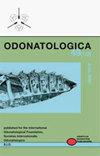The larva of the endangered Heterophaea barbata (Martin, 1902), from Luzon Island, the Philippines (Odonata: Euphaeidae)
IF 0.5
4区 农林科学
Q4 ENTOMOLOGY
引用次数: 0
Abstract
. The final instar larva of the large, spectacular Philippine and Luzon endemic eu-phaeid damselfly Heterophaea barbata (Martin, 1902) is described and illustrated for the first time, based on field collected exuviae of both sexes. Identification is by supposition, but larvae of the only other euphaeid on the island, Euphaea refulgens Hagen in Selys 1853, have been previously described and illustrated and can be confidently ruled out. The specimens are exceptionally large for the family and present several novel structural features not recorded in other euphaeid genera. The antennae of the principal specimen studied were asymmetric in length and numbers of segments, suggestive of a possible teratological event caused by genetic load or environmental factors during development. This and other specimens exhibited up to 14 antennomeres, more than hitherto recorded for any odonate larvae.菲律宾吕宋岛濒临灭绝的 Heterophaea barbata (Martin, 1902) 的幼虫(蜻蜓目:大戟科)
.本文首次描述了菲律宾和吕宋岛特有的大型、壮观的豆娘 Heterophaea barbata(Martin,1902 年)的末龄幼虫,并根据野外采集的雌雄幼虫绘制了插图。鉴定是通过推测进行的,但岛上唯一的一种豆娘(Euphaea refulgens Hagen in Selys 1853)的幼虫此前已被描述和图解过,因此可以肯定地排除这一可能性。这些标本在该科中格外大,并呈现出其他 euphaeid 属中未记录到的几种新的结构特征。所研究的主要标本的触角在长度和节数上都不对称,这表明可能是发育过程中的遗传负荷或环境因素造成的畸变。该标本和其他标本表现出多达 14 个触角,比迄今为止记录的任何一种蜻蜓幼虫都要多。
本文章由计算机程序翻译,如有差异,请以英文原文为准。
求助全文
约1分钟内获得全文
求助全文
来源期刊

Odonatologica
生物-昆虫学
CiteScore
1.20
自引率
0.00%
发文量
1
审稿时长
>12 weeks
期刊介绍:
Odonatologica publishes original articles in all fields of odonatology. Review articles, i.e., original and critical accounts of important, rounded-off topics, are also explicitly welcome, but authors who plan to write a review should contact the Editor first.
 求助内容:
求助内容: 应助结果提醒方式:
应助结果提醒方式:


